Magical San Miguel
 Sunday, January 16, 2022 at 02:16PM
Sunday, January 16, 2022 at 02:16PM 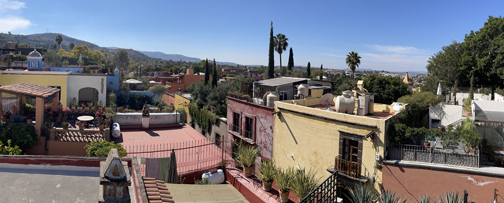 Winding through the volcanic Sierra Central mountains in the state of Guanajuato, down into the heart of colonial San Miguel de Allende after a grueling six-and-a-half hour trip from Mexico City, we feel relieved to finally arrive, even though it’s midnight. We were over four hours late due to flight delays, and a much longer than expected road trip, but thankfully Carmen is still there to welcome us to our lovely rental home for the week—Casa Agave—which is fortunately pre-stocked with the makings for margaritas and a plate of quesadillas with guacamole.
Winding through the volcanic Sierra Central mountains in the state of Guanajuato, down into the heart of colonial San Miguel de Allende after a grueling six-and-a-half hour trip from Mexico City, we feel relieved to finally arrive, even though it’s midnight. We were over four hours late due to flight delays, and a much longer than expected road trip, but thankfully Carmen is still there to welcome us to our lovely rental home for the week—Casa Agave—which is fortunately pre-stocked with the makings for margaritas and a plate of quesadillas with guacamole.
San Miguel is over four hundred and sixty years old. It sits at 6,400 feet in the central highlands of Mexico on an enormous fertile plateau, known as the Bajio. This venerable colonial town is rightly considered a crown jewel of Mexico. 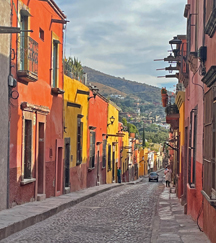
We were last in San Miguel over 15 years ago, and the rough cobbled streets and thin mountain air are a bit of a toll on our older selves. Our earlier taxing trek through Benito Juarez airport at 7,300 feet felt more like Cuzco at thirteen thousand. We’ll slowly acclimate to both.
Despite the 15-year lapse, the preserved 16th-17th century architecture, colonial beauty of winding cobblestone streets flanked by bright colorful adobe walls pierced with stunning doorways, wall fountains around every corner, and vibrant flora are mostly unchanged. Yellow Jacaranda, crimson and fuchsia Bouganvilla, palms, ficus, agaves, and the lollipop pollarded laurel trees of the central square—El Jardín—all mix together in a riot of color and form.
We are traveling with a very dear long-time friend, and Casa Agave is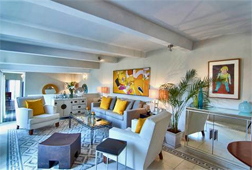 a perfect setup, with one bedroom at the front, with terrace; one bedroom at the rear, with private garden; study, living room, dining room and kitchen in the center; and a full panoramic-view rooftop garden over all. Agave is situated in the first block of Calle Aldama, just off the central Jardín, and we come to learn it’s the most photographed view in town, combining a quintessential colorful colonial block with the stunning view of the Parroquia de San Miguel, the pink-and-orange wedding-cake of a parish church (not a cathedral, though often mis-spoken as such) which we learn is the most photographed church in all Mexico. Humorously, a fellow with a Zapatista mustache, sombrero, and bandito getup parks a
a perfect setup, with one bedroom at the front, with terrace; one bedroom at the rear, with private garden; study, living room, dining room and kitchen in the center; and a full panoramic-view rooftop garden over all. Agave is situated in the first block of Calle Aldama, just off the central Jardín, and we come to learn it’s the most photographed view in town, combining a quintessential colorful colonial block with the stunning view of the Parroquia de San Miguel, the pink-and-orange wedding-cake of a parish church (not a cathedral, though often mis-spoken as such) which we learn is the most photographed church in all Mexico. Humorously, a fellow with a Zapatista mustache, sombrero, and bandito getup parks a 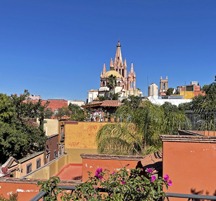 donkey a few houses down the street and inveigles pesos out of tourists to take their photos atop the long-suffering ass, with the amazing church in the background.
donkey a few houses down the street and inveigles pesos out of tourists to take their photos atop the long-suffering ass, with the amazing church in the background.
Needing supplies, we head out the next morning to trek around town. We cross El Jardín with its shady square-shaped park with stout black iron benches spotted about. A white gazebo in the center serves as a year-round stage for a variety of entertainment. Vendors with small stands sell balloons, dulces, sweets, cotton candy, roasted corn on the cob, and tacos. There is a great horse-drawn ice cream wagon, where people queue for ice cream cones in a huge variety of flavors. The enormous Christmas tree is still up in front of the church, and as we pass a very dressed-up young woman is celebrating her quinceanera—15th birthday—with her cortege of admirers in front of 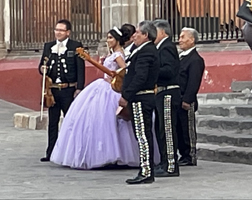 the church plaza.
the church plaza.
Blocks further on, we arrive at the central food market—Mercado Ignacio Ramirez—markets are always a must for us. Ropes of chiles, mounds of guavas, melons, star fruit, passion fruit, cherimoya and of course avocados. I ask for two, and the stall holder asks “hoy o manana?”—today or tomorrow. I tell her cada una, and she gently feels the fruits to find one perfect for this evening, and a second which will be perfect tomorrow—she is of course right on. Calle Colegio adjacent to the market is side-by-side butchers, fish monger, tortillerilla, cremeria and chicken rotisserie—where for 180 pesos, or around nine bucks, we receive a golden crispy chicken, roast potatoes and onions, and two flavors of salsa. Dinner easily solved, with the addition of a bottle of Casa Madero red-blend wine from Baja.
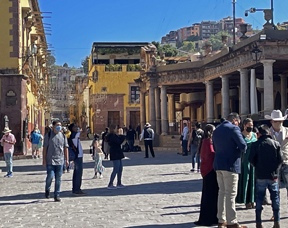 The long loved ‘Blue Door’ pandaderia in Calle Relox was for years the place in town for Mexican pastries, but it seems that Panio, a two-shop chain has bumped it aside as the place for pan dulce, croissants, crusty loaves and delicious cookies. We stop almost daily to take baked goodies back to Casa Agave. La Europea in Canal, just off the main square, has long been the go to shop for great Mexican wines, a huge selection of Tequilas, and most any other beverage one needs. Two doors away is Bugambillas—Desde 1945–where on a tree shaded patio surrounded by vine-covered burnt umber walls we share mini sopes topped with beans, shredded beef and salsa, tinga de pollo tostadas and tacos de carnitas—with margaritas rocas, of course. The place really was founded in 1945, and has been serving Miguelenos, expats and tourists for over seven decades.
The long loved ‘Blue Door’ pandaderia in Calle Relox was for years the place in town for Mexican pastries, but it seems that Panio, a two-shop chain has bumped it aside as the place for pan dulce, croissants, crusty loaves and delicious cookies. We stop almost daily to take baked goodies back to Casa Agave. La Europea in Canal, just off the main square, has long been the go to shop for great Mexican wines, a huge selection of Tequilas, and most any other beverage one needs. Two doors away is Bugambillas—Desde 1945–where on a tree shaded patio surrounded by vine-covered burnt umber walls we share mini sopes topped with beans, shredded beef and salsa, tinga de pollo tostadas and tacos de carnitas—with margaritas rocas, of course. The place really was founded in 1945, and has been serving Miguelenos, expats and tourists for over seven decades.
The house’s rooftop terrace is a great place for a morning or afternoon read, beverage at hand, shaded from the sun in the azure sky. Potted trees and plants make the area a veritable garden, and the view sweeps from the south, where the Luna rooftop bar of the luxe Rosewood Hotel is filled with revelers, all the way around to the Parrochia spires, and the hilly Balcones section of town. There’s a small outdoor kitchen, which we’ll use tomorrow night to grill lamb chops acquired on our foray to the market and butcher.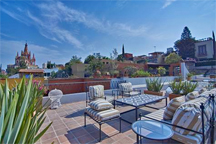
San Miguel is a rumpled blanket of a hill town—all ups and downs, with little flat. Two long blocks south is the lush Parque Benito Juarez, sloping up the the Lavaderos del Chorro, the old stone public Laundry basins. There late morning the next day, we meet Les, who will lead us on a three-hour wandering food tour of town. He’s an expat pastry chef, who had a bakery elsewhere in Mexico, and we find was the opening pastry chef at the Lodge in Sonoma. At various stops, we sample quesadillas de Oaxacan queso and flor de calabasa, Peruvian snapper in aquachile, deeply flavored black-mole enchiladas, ice cream from the nun’s cart outside the Temple of Immaculate Conception, and crunchy hot churros with dulce de leche in the shade of the square fronting the Templo de San Francisco. We’ll just have margaritas and totopos and guacamole for dinner.
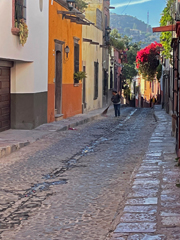
The town is packed with boutiques, craft, textile and ceramic shops, galleries and design stores, and next morning we browse Trinitate, adjacent to the Parroquia for hand-made local ceramics, Sollano 16, an elegant furnishing shop, Doce 18, a design concept store, and a hand-crafted women’s clothing store just steps from our front door, where both ladies acquire lovely things.
Half way down Aldama to the Parque Juarez is the newish Hotel Matilda. An ochre vine-draped wall and simple stone doorway are all that shows on the street, but within the hotel expands to an art-filled lounge, and behind a lovely open terrace restaurant and the Monkey Bar. Sweat beaded, salt-rimmed Margaritas arrive shortly to accompany our perusal of the upscale refined Mexican menu. We elect to share buratta with figs and duck jamon, a very elegant tamale filled with pibil-roast duck and xnipe chile, and requeson-cheese stuffed ravioli with wild mushroom sauce. By a good margin the most elegant fare we will sample in town.
The day before departure, we must take PCR test for re-entry, and there is a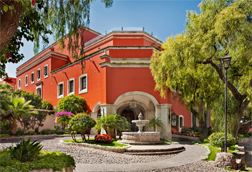 mobile testing station set up by the Rosewood. So we wander down, killing two birds, get our tests (negative results by email in half hour) and then enter the super deluxe Rosewood courtyard, designed to mimic a wealthy mansion of yore, and head up to the Luna terrace for bracing mezcal margaritas, and a variety of nibbles. There's a mixture of gringos and wealthy chilangos from Mexico City, but no locals at these prices. Despite the Mexican design and view, one could really be in a five-star hotel most anywhere in the world.
mobile testing station set up by the Rosewood. So we wander down, killing two birds, get our tests (negative results by email in half hour) and then enter the super deluxe Rosewood courtyard, designed to mimic a wealthy mansion of yore, and head up to the Luna terrace for bracing mezcal margaritas, and a variety of nibbles. There's a mixture of gringos and wealthy chilangos from Mexico City, but no locals at these prices. Despite the Mexican design and view, one could really be in a five-star hotel most anywhere in the world.
Dinner our final night takes us to the open terrace of Atrio, where we are seated with a direct view across Aldama to the 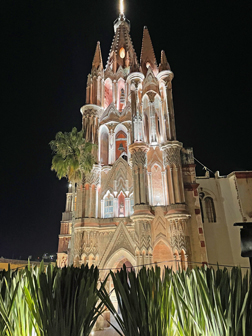 spectacularly night-lit church spires, topped with an ink-blue sky and three-quarter moon. Atrio sports a very interesting menu, and after sharing tiradito of Hamachi and duck gyozas, we can’t resist our favorite cut from the cow, tapa de ojo de bife, or prime-graded rib-eye cap. Technically the spinalis dorsi, this thin cut covering the whole prime rib is tender, marbled and deeply flavorful. Any competent butcher will attest to its being one of, if not the finest cut. Charred on the outside and rare in the middle, it is spectacular.
spectacularly night-lit church spires, topped with an ink-blue sky and three-quarter moon. Atrio sports a very interesting menu, and after sharing tiradito of Hamachi and duck gyozas, we can’t resist our favorite cut from the cow, tapa de ojo de bife, or prime-graded rib-eye cap. Technically the spinalis dorsi, this thin cut covering the whole prime rib is tender, marbled and deeply flavorful. Any competent butcher will attest to its being one of, if not the finest cut. Charred on the outside and rare in the middle, it is spectacular.
Back at Casa Agave, a final view of the Parrochia from the terrace, a dram of Bowmore peated scotch, and we close our visit to one of the loveliest places in the Americas.